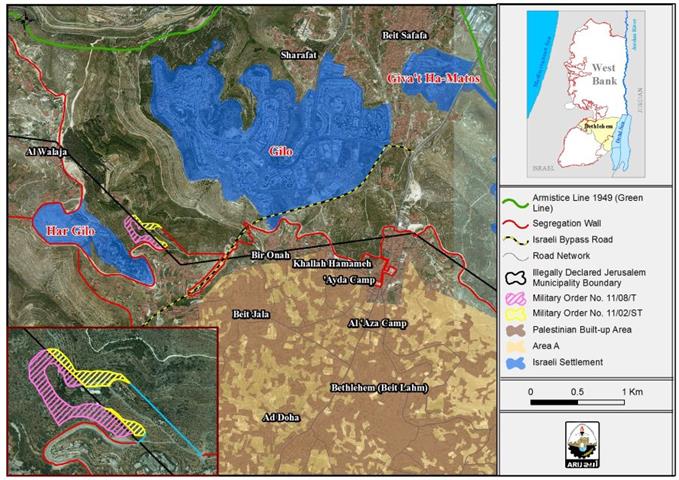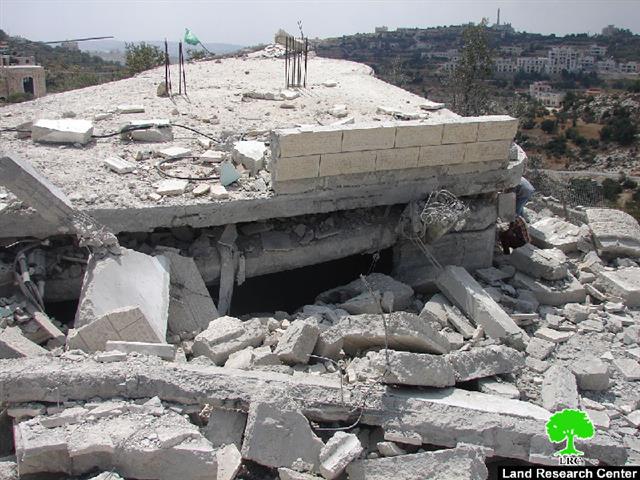The Israeli Supreme Court issued on the 11th of August 2014 a ruling concerning the Israeli Segregation Wall in Cremisan area in Beit Jala city. The ruling came following the August 4th, 2014 hearing which was held to review the current route of the Israeli segregation wall which is threatening to isolate and confiscate the land of Palestinian families and the Cremisan Salesian monasteries in Beit Jala city.
The court’s ruling asked the State of Israel to take into consideration different options for re-routing the segregation wall in the area, allowing the two Salesian Monasteries to remain on the Palestinian side of the wall. The Court also gave the state of Israel until the 4th of September 2014 to respond to the court. The court’s ruling has serious implications:-
-
The ruling of the Israeli Supreme Court comes to consolidate Israel’s decision to construct the Segregation Wall in the Cremisan Valley area in Beit Jala city.
-
The Court’s ruling only took into consideration the respect of religious status for each of the Salesian Sisters Monastery and Cremisan Monastery for monks and the respect of religious rights in the area and the importance of the geographical unity of the aforementioned monasteries; however, the ruling neglected the Palestinian legal pleadings in that regard and the rights of the fifty-eight Palestinian families in the area of Beit Jala, which, the wall will come entirely on their land, and their main source of livelihood.
-
The court's ruling to amend the route of the wall to maintain the geographical unity of the two monasteries in the area will not ease the suffering that the wall will cause for the people of Beit Jala city and especially Palestinian landowners, as the wall will, first and foremost, isolate the land from its owners without taking into account what this land represents to them.
-
The current route of the Israeli Segregation wall is illegal and is irrelevant to "Israel's security claims"; however, in the end, Israel aims to eliminate the only remaining Green area in the city of Beit Jala after besieging it by the wall from all directions. See Map 1
Map 1: the current path of the Israeli Segregation Wall in Cremisan area.
The Israeli security allegations clearly aim at redrawing the boundaries of Jerusalem city and annex the whole area, illegally and unilaterally, into Israel. Not forgetting to mention that the Israeli settlement plans in the Cremisan area will eventually cut the contiguity of the Palestinian communities; at the same time, will allow for the geographical expansion of the existing Israeli settlements in the area and link these settlements with others surrounding them from the north and the south. For more details, click on the following link: Israel comprises Cremisan Rights camouflage its aggression on the occupied Gaza Strip
The Council for Peace and Security (CPS) proposes a new Wall route in the Cremisan Valley Area
The Council for Peace and Security presented to the Israeli court a new proposal of the route of the Israeli Segregation wall in the Cremisan area. The route comes as follows:-
-
The first section of the revised wall route to be built on the eastern part of the two Salesian Monasteries and parallel to Gilo settlement.
-
The second section of the proposed wall route (by CPS) stretches towards the north (north of the two Salesian Monasteries), and parallel to the 1949 Armistice Line, and continues northwest in the direction of Al Walajeh village to connect with the endpoint of the wall section already built on the north and northeastern side of Al Walajeh village. This section comes to cancel the wall section that currently separates Al Walajeh village from Cremisan Valley.
-
The third section of the wall goes parallel with Har Gilo settlement from its eastern side, completely separates it (Har Gilo) from Cremisan Valley area and cancels the current wall section that is planned to be built in that specific area (as delineated by the Israeli occupation army (IOA)). Accordingly, the only connection point for Gilo settlement with the surrounding settlements and Jerusalem will be from the western side of the settlement; therefore, maintaining the lands of Cremisan (the property of the two Salesian Monasteries) and the land of the 58 Palestinian families on the Palestinian side of the wall. See Map 2
Map 2: The Israeli Segregation Wall Route as proposed by the CPS
The wall, as suggested by the CPS, have positive impacts,
-
90% of the land threatened of confiscation and isolation in the Cremisan Valley area (due to the current wall route as presented by the IOA) will stay on the Palestinian side of the wall (if endorsed and implemented) and Palestinians will continue to access it as before.
-
The wall route (as proposed by the CPS) will maintain one of the few green areas left for Beit Jala city citizens and will help sustain the high biodiversity and the abundant natural resources in the area in the future.
-
Damages that will be caused to the Palestinian land in the Cremisan area, according to CPS wall proposal, are much less (environmentally and economically) comparing to what the current wall route has already caused and is expected to cause in case Israel maintains the current route of the wall in the area as is (wall as delineated by the IOA).
-
The proposed wall route will reduce the migration of Palestinians out of the country, where the Cremisan area is one of the few outlets and expansion areas left for the Palestinians in Beit Jala in the future. The current route of the wall (as proposed by the IOA) will come on the entire Cremisan property and deprive Palestinian land owners of their property as well. This in turn will contribute, to a large extent, in the migration of Palestinians outside Palestine because of the unilateral measures imposed by the Israeli government against the Palestinians and the exploitation of their rights.
-
The proposed wall route will protect the educational process in the area and will give the possibility of the expansion of the Nuns Salesian school in the future and accommodate more students. It is worth mentioning that the Salesian Nuns School contribute to easing the burden on Palestinian families with limited income whose children attend the school to benefit from the educational services offered by the school which charges minimum fees.
To conclude
The Israeli court neglected Palestinian land owners’ pleadings and their rights in the Cremisan area and emphasized only on respecting freedom of religion in the area without taking into account the moral and the economic damage that the current wall route has already caused and will continue to do if Israel decides to carry on with its plan in the area.
This is considered a clear and explicit breach of the signed agreements, most specifically, the International Covenant on Economic, Social and Cultural Rights which was Adopted and opened for signature, ratification and accession by General Assembly resolution 2200A (XXI) of 16 December 1966 entry into force 3 January 1976, in accordance with article 27, which Recognizes that, in accordance with the Universal Declaration of Human Rights, the ideal of free human beings enjoying freedom from fear and want can only be achieved if conditions are created whereby everyone may enjoy his economic, social and cultural rights, as well as his civil and political rights. The Covenant also considers the obligation of States under the Charter of the United Nations to promote universal respect for, and observance of, human rights and freedoms[1].
Prepared by:
The Applied Research Institute – Jerusalem

[1] International Covenant on Economic, Social and Cultural Rights
http://www.ohchr.org/EN/ProfessionalInterest/Pages/cescr.aspx














